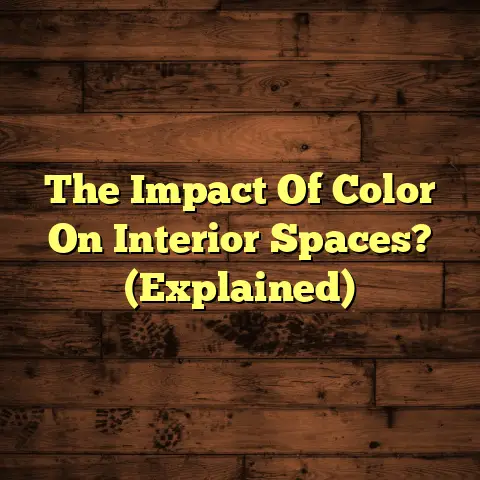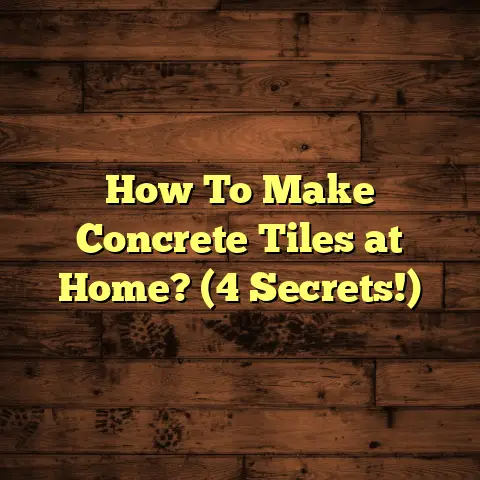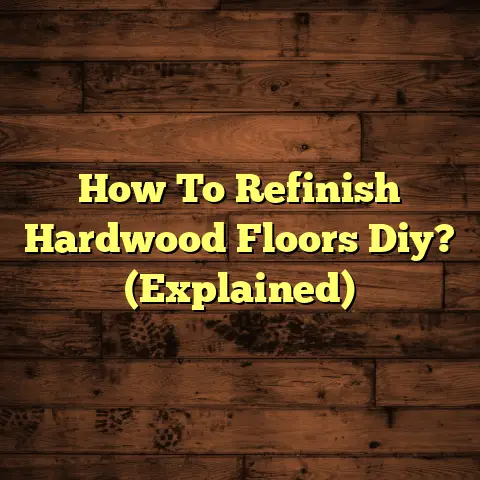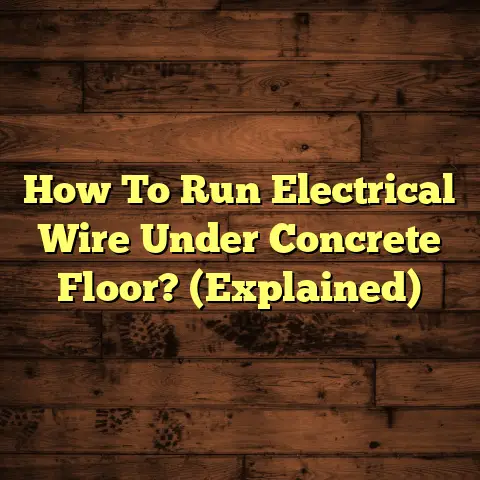Urban Gardening Trends: Impact on Flooring? (Top 3!)
One thing I keep hearing is this myth: “Urban gardening is only about growing plants; it has no impact on the surrounding environment or interior spaces.”
Seriously?
That’s like saying a leaky faucet doesn’t affect your water bill!
This idea completely misses the real connection between bringing the outdoors in and how it affects our homes, especially our flooring.
Think about it: soil, water, humidity… These are all flooring’s worst enemies!
That’s why I’m here to break down how urban gardening trends are changing the game for flooring choices, materials, and even design.
Let’s dive in!
Section 1: The Rise of Urban Gardening
Overview
Urban gardening is exploding!
It’s not just a hobby anymore; it’s a movement.
We’re seeing more and more people turning their balconies, rooftops, and even indoor spaces into mini-farms and green oases.
Why? Well, a few reasons…
Statistics & Trends
The stats don’t lie.
According to a report by the National Gardening Association, over 35% of all US households are growing food at home or in community gardens.
That’s a huge number!
And it’s not just in rural areas. Cities are leading the charge.
- Community gardens are popping up in vacant lots.
- Rooftop farms are becoming trendy on apartment buildings.
- Balcony gardening is a must-have for urban dwellers.
I’ve personally seen a massive increase in requests for flooring that can handle the unique challenges of these spaces.
Cultural Shifts
This isn’t just about growing tomatoes.
Urban gardening reflects a deeper cultural shift towards:
- Sustainability: People want to reduce their carbon footprint and grow their own food.
- Food Security: Knowing where your food comes from is more important than ever.
- Wellness: Gardening is therapeutic and connects us with nature.
It’s about taking control and creating a healthier, more sustainable lifestyle, and that extends to our homes and the materials we choose.
Section 2: Impact on Flooring (Trend #1: Indoor Vertical Gardens)
Description
Okay, let’s get into the first big trend: indoor vertical gardens.
These are walls of plants, growing upwards instead of outwards.
They’re super stylish, space-saving, and bring a ton of greenery into your home.
But…and this is a big but…they can be a disaster for your floors if you’re not careful.
Flooring Considerations
Water, water everywhere!
That’s the biggest challenge with vertical gardens.
Even with the best irrigation systems, spills happen.
And constant humidity can wreak havoc.
That’s why you need to think very carefully about your flooring choices:
- Waterproof Vinyl: Luxury vinyl plank (LVP) or sheet vinyl are great options. They’re 100% waterproof and can handle spills and humidity like a champ.
- Tile: Porcelain or ceramic tile is another excellent choice. It’s durable, water-resistant, and comes in tons of styles.
- Drainage Systems: Consider installing a hidden drainage system underneath your vertical garden to catch any excess water. This is a game-changer!
- Waterproof Membranes: Before installing any flooring, make sure to apply a waterproof membrane to the subfloor. This adds an extra layer of protection.
- Weight Distribution: Vertical gardens can get heavy, especially when the soil is wet. Ensure the flooring structure and subfloor can handle the added weight to prevent sagging or structural issues.
Case Studies
I worked on a project last year in a downtown loft where the client wanted a huge vertical garden in their living room.
We ended up installing a porcelain tile floor with a hidden drainage system.
It looked amazing, and they haven’t had any water damage issues since!
I also helped a homeowner install a smaller vertical garden in their kitchen using LVP.
We made sure to seal all the seams and edges really well to prevent any water from seeping through.
The key is to plan ahead and choose materials that can handle the moisture.
Section 3: Impact on Flooring (Trend #2: Sustainable Material Use)
Description
Next up: sustainable materials!
People are becoming more conscious of the environmental impact of their choices, and that includes gardening and flooring.
We’re seeing a huge push for using reclaimed wood, bamboo, recycled composites, and other eco-friendly materials in urban gardening.
Flooring Integration
The good news is that these sustainable materials are making their way into flooring too!
- Reclaimed Wood Flooring: Adds character and reduces waste.
- Bamboo Flooring: A fast-growing, renewable resource.
- Cork Flooring: Made from the bark of cork trees, which regenerates.
- Recycled Content Flooring: Made from recycled plastic or other materials.
- Linoleum: Made from natural materials like linseed oil, cork dust, and wood flour. It’s biodegradable and durable.
I’m seeing more and more clients asking for these options.
They want their homes to be beautiful and eco-friendly.
Design Aesthetics
The cool thing is that sustainable flooring can really complement an urban garden.
Think about it:
- Reclaimed wood flooring with a rustic vertical garden.
- Bamboo flooring with a zen-like indoor garden.
- Cork flooring with a vibrant herb garden.
It’s all about creating a cohesive, natural, and environmentally friendly living space.
Section 4: Impact on Flooring (Trend #3: Indoor-Outdoor Living Spaces)
Description
Okay, this is a big one: blurring the lines between indoor and outdoor spaces.
Urban gardening is making it easier than ever to create seamless transitions between your living room and your balcony or patio.
Think of it as extending your living space into the great outdoors (or at least, the urban outdoors!).
Flooring Solutions
To make this work, you need flooring that can handle both indoor and outdoor conditions.
Here are some top choices:
- Porcelain Tiles: These are incredibly durable, water-resistant, and can be used both indoors and outdoors.
- Outdoor Rugs: These add warmth and comfort to outdoor spaces and can be easily cleaned.
- Concrete Flooring: Polished concrete is a modern and durable option that can be used indoors and outdoors.
- Composite Decking: For balconies or patios, composite decking is a low-maintenance and weather-resistant option.
- Stone Pavers: Natural stone like slate or flagstone can create a seamless transition between indoor and outdoor spaces, offering durability and a natural aesthetic.
The key is to choose materials that can withstand moisture, sunlight, and heavy foot traffic.
Design Challenges
Of course, there are some challenges to consider:
- Moisture Control: Outdoor spaces are exposed to rain, snow, and humidity. Make sure your flooring is properly sealed and waterproofed.
- Durability: Outdoor flooring needs to be able to handle heavy foot traffic, furniture, and the elements.
- UV Resistance: Sunlight can fade and damage some flooring materials. Choose UV-resistant options to prevent discoloration.
- Drainage: Proper drainage is essential to prevent water from pooling on your outdoor flooring. Ensure there’s a slight slope away from your house.
- Temperature Fluctuations: Outdoor flooring materials need to withstand temperature changes without cracking or warping.
I always recommend consulting with a flooring professional to choose the best materials for your specific climate and conditions.
Section 5: The Future of Urban Gardening and Flooring
Innovative Solutions
So, what does the future hold? I think we’re going to see some amazing innovations in both urban gardening and flooring:
- Smart Flooring: Imagine flooring that can detect moisture levels and adjust irrigation systems automatically.
- Integrated Planting Systems: Flooring that incorporates built-in planters or growing beds.
- Living Floors: Floors made from living moss or other plants (I know, it sounds crazy, but it’s possible!).
- Self-Healing Concrete: Concrete that can repair cracks on its own, extending the lifespan of outdoor flooring.
- Solar-Powered Flooring: Flooring that generates electricity from sunlight, powering your garden lighting or irrigation system.
It’s going to be a wild ride!
Interdisciplinary Collaboration
To make these innovations a reality, we need more collaboration between:
- Landscape Architects
- Interior Designers
- Flooring Manufacturers
By working together, we can create truly harmonious and sustainable spaces that seamlessly blend the indoors and outdoors.
Conclusion
Okay, let’s wrap things up.
We’ve covered a lot of ground, from the rise of urban gardening to the impact on flooring choices.
The key takeaway is this: urban gardening is not just about growing plants.
It’s about creating a healthier, more sustainable, and more beautiful living environment.
And that has a huge impact on the flooring we choose.
So, I challenge you to rethink your perceptions of urban gardening.
It’s not just a trend; it’s a movement that’s transforming the way we live in cities.
Call to Action
Ready to get your hands dirty?
I encourage you to explore urban gardening in your own home.
Whether it’s a small herb garden on your windowsill or a full-blown vertical garden in your living room, start small and see what you can create.
And don’t forget to think about your flooring!
Choose materials that are durable, water-resistant, and sustainable.
With a little planning and creativity, you can create a beautiful and functional space that brings the outdoors in.
Happy gardening!





